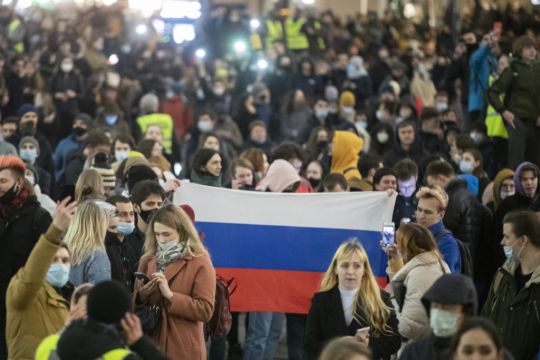Thousands of supporters of imprisoned Russian opposition leader Alexei Navalny have marched in central Moscow as part of nationwide demonstrations calling for his freedom.
More than 1,000 people were arrested across the country in connection with the protests, according to a human rights group that monitors political repression.
Many were seized before the protests even began, including two top Navalny associates in Moscow.
Mr Navalny’s team called for the unsanctioned demonstrations after weekend reports that his health is deteriorating.

“The situation with Alexei is indeed critical, and so we moved up the day of the mass protests,” Vladimir Ashurkov, a close Navalny ally and executive director of the Foundation for Fighting Corruption, told The Associated Press.
“Alexei’s health has sharply deteriorated, and he is in a rather critical condition. Doctors are saying that judging by his test (results), he should be admitted into intensive care.”
Mr Navalny’s organisation called for the Moscow protesters to assemble on Manezh Square, just outside the Kremlin walls, but police blocked it off.
Instead, a large crowd gathered at the nearby Russian State Library and another lined Tverskaya Street, a main avenue that leads to the square. Both groups then moved through the streets.

“How can you not come out if a person is being murdered — and not just him. There are so many political prisoners,” said Nina Skvortsova, a Moscow protester.
In St Petersburg, police blocked off Palace Square, the vast space outside the Hermitage museum and protesters instead crowded along nearby Nevsky Prospekt.
It was unclear if the demonstrations would match the size and intensity of nationwide protests that broke out in January after Mr Navalny, President Vladimir Putin’s most prominent opponent, was arrested.
Turnout estimates varied widely. Moscow police said 6,000 people demonstrated in the capital while an observer told Mr Navalny’s YouTube channel that the crowd was about 60,000.

The OVD-Info group reported 1,004 arrests in 82 cities.
Mr Navalny’s team called the nationwide protests for the same day that Mr Putin gave his annual state-of-the-nation address.
In his speech, he denounced foreign governments’ alleged attempts to impose their will on Russia.
Mr Putin, who never publicly uses Mr Navalny’s name, did not specify to whom the denunciation referred, but Western governments have been harshly critical of Mr Navalny’s treatment and have called for his release.
In Moscow, Navalny spokeswoman Kira Yarmysh and Lyubov Sobol, one of his most prominent associates, were detained by police in the morning.
Ms Yarmysh, who was put under house arrest after the January protests, was detained outside her apartment building when she went out during the one hour she is allowed to leave, said her lawyer, Veronika Polyakova.
She was taken to a police station and charged with organising an illegal gathering.

Ms Sobol was removed from a taxi by uniformed police, said her lawyer, Vladimir Voronin.
OVD-Info reported that police searched the offices of Mr Navalny’s organization in Yekaterinbrug and detained a Navalny-affiliated journalist in Khabarovsk.
In St Petersburg, the State University of Aerospace Instrumentation posted a notice warning that students participating in unauthorised demonstrations could be expelled.
Mr Navalny, 44, was arrested in January on his return from Germany, where he had spent five months recovering from a nerve agent poisoning he blames on the Kremlin. Russian officials have rejected the accusation.
Soon after, a court found that his long stay in Germany violated the terms of a suspended sentence he was handed for a 2014 embezzlement conviction and ordered him to serve two and a half years in prison.
He began the hunger strike to protest over prison officials’ refusal to let his doctors visit when he began experiencing severe back pain and a loss of feeling in his legs. The penitentiary service said Mr Navalny was getting all the medical help he needs.
But his physician, Dr Yaroslav Ashikhmin, said recently that test results showed sharply elevated levels of potassium, which can bring on cardiac arrest, and heightened creatinine levels that indicate impaired kidneys and he “could die at any moment”.







